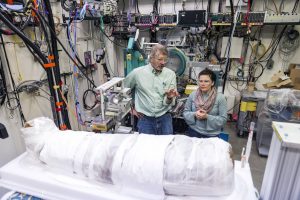An X-ray scattering experiment has been performed on a 1900-year-old Egyptian mummy of young girl to obtain new information about her, including how her body was prepared, what items she may have been buried with, the quality of her bones and what material is present in her brain cavity.

Researchers at Northwestern University Feinberg School of Medicine performed an all-day X-ray scattering experiment in the end of November. The Roman-Egyptian mummy of a 5-year-old girl dates back to the late 1st century AD and was uncovered at Egyptian site of Hawara, in an underground chamber with four other mummies. It is wrapped in linen, with a portrait in beeswax and pigments on wood. The outermost wrappings have been arranged in an ornate geometric pattern of overlapping rhomboids and also serve to frame the portrait. The portrait is a lifelike painting of the deceased individual. The girl is portrayed with dark hair gathered at the back and wearing a crimson tunic, along with gold jewellery. She is believed to have been from a high-status family.


(after PhysOrg, Jim Prisching & Northwestern University)